
35% off Koro Sun Dive Resort, Savusavu
Dive Savusavu and the incredible Namena Marine Reserve staying at Koro Sun Resort and save 35% on all room types – PLUS! Kids stay and eat for free!
Travel between: 01 May 24 and 31 Mar 25
Check out a selection of the best diving deals on offer!

Dive Savusavu and the incredible Namena Marine Reserve staying at Koro Sun Resort and save 35% on all room types – PLUS! Kids stay and eat for free!
Travel between: 01 May 24 and 31 Mar 25
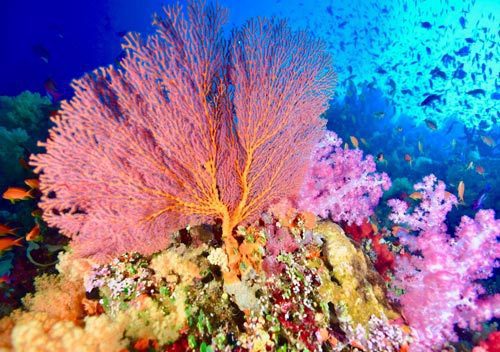
Dive Bligh Water with our unbeatable special offer – stay 5 nights/pay 3, stay 7/pay… 50% more dives + PLUS loads more extras!
Travel between: 01 Jan 25 and 31 Mar 25

Waidroka Bay Resort Last Minute Special is available for a short time only – 5 and 7 night packages available, all meals, up to 13 dives inc. shark dives!
Travel between: 15 Jan 24 and 30 Apr 24
Read about some of our top places and things to see
Given Fiji’s lush green slopes, aquamarine waters and dazzling white beaches, it’s not hard to imagine that underwater, Fiji also offers a stunning diversity of terrain and variety of marine life. Circled by three of the world’s largest barrier reefs, Fiji offers lots of lazy lagoon diving on sheltered reefs teeming with friendly reef fish, as well as great wall diving along the barrier reefs. There are plenty of dive resorts to suit every budget scattered throughout the Fiji Islands.
Acknowledged as the soft coral capital of the world, spectacular diving awaits in places like Vatu-I-Ra where colourful coral clad pinnacles rise from 40m to just below the surface, and Taveuni’s Rainbow Reef named for its extravagant mix of soft and hard corals, and colourful sea fans and anemones. For thrill-seekers, Fiji’s shark diving sites offer the opportunity to safely observe several species of sharks up close, and you can even snorkel with reef sharks and manta rays.
For beginners, if you’re looking to graduate from snorkeler to certified diver, Fiji’s warm clear waters provide a great place to try diving for the first time. As well as being fully PADI or SSI qualified, Fijian dive instructors know you’re on holiday and so will make your first underwater experience or dive course just as much fun as it can be.
Fiji caters for all budgets as well, whether you’re looking for an affordable eco-resort, a generous family-friendly resort, or a luxury, adults only couples retreat, you’ll find what you’re looking for here. Explore your diving options in this brochure then hop online and book your Fijian diving holiday.
Browse the different kinds of diving on offer in the Dive Sites tab, then deep dive into that region to see who can take you diving there and where to stay. Or send us an enquiry and we can help you find the best place for you.
Fiji offers quarantine free travel to fully-vaccinated travellers from all over the world. Entry requirements have now been simplified to make it even easier to plan a holiday here. Simply show evidence of the following at check-in before your departure flight:
Fiji Islands, an archipelago in Melanesia in the South Pacific Ocean, is 3,300 km due east of Cairns and 2,000 km due north of New Zealand and just 3½ hours flying time from Sydney.
The map below shows the different dive areas in Fiji.
Yasawa Islands, Fiji
Kadavu, Fiji
Beqa Lagoon & Pacific Harbour => Shark diving
Fiji
Taveuni, Somosomo Strait, Fiji
Nadi is the international airport for Fiji, and Fiji Airways flies directly to Brisbane, Sydney, Melbourne, Auckland, Christchurch, Hong Kong, Singapore, Honolulu, Los Angeles, San Francisco, as well as some of the smaller regional islands such as Vanuatu and the Solomon Islands. Virgin and Jetstar fly from Australia, and Qantas and Air NZ have flights to LA and San Fran which stop off at Nadi.
If you are traveling from Australia you can connect to Nadi through Sydney, Melbourne or Brisbane using Fiji Airways, Qantas or Virgin Australia.
If you are traveling from the United States or Canada, you can choose to fly direct from Los Angeles, San Francisco or through Honolulu, Hawaii with Fiji Airways.
If you are travelling from within Europe, you can connect through Singapore, Hong Kong or Seoul with Fiji Airways or Korean Airways respectively.
In most cases, you will stay in a resort of one form or another (or aboard a liveaboard or small cruise ship). The resort may be a dive-focussed resort, a resort with its own ‘dive shop’, or a resort serviced by a local dive shop or other resort dive shop.
Fiji is no backwater when it comes to diving. Boats are surveyed, and most of the gear is modern and well serviced. Dive Centres are certified, usually PADI or SSI, and most dive centres are qualified to take Discover Scuba Divers and teach Open Water and Advanced courses.
Most of the dive guides – mainly Fijian, but not always – stick with a particular dive centre for a while, so you’ll find them very knowledgeable about the areas they dive guide in. You’ll also find them very friendly.
Each region has number of resorts and dive centre to suit your budget. So select a region depending on what you want to see, then choose a resort that will give you the kind of diving at the price you’re wanting. Bear in mind some of the other activities on offer at each resort too. Some offer infinite snorkelling right of the beach – others don’t. Once you’re at a resort, it can difficult to access water-based activities not offered by that resort.
The map below shows the location of the Dive Resorts in Fiji.
Nai’a Liveaboard, Lautoka, Fiji
Captain Cook at Denarau, Fiji
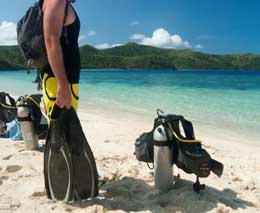
Barefoot Manta Resort, Yasawa Islands, Fiji
Mantaray Island Resort, Yasawa Islands
Castaway Island Diving, Mamanuca Islands, Fiji
Matava Resort, Kadavu Island, Fiji
Barefoot Kuata Resort at Kuata Island
Jean-Michel Cousteau Resort, Savusavu
Paradise Taveuni Resort, Taveuni, Fiji
Ra Divers at Volivoli Beach Resort, Rakiraki, Fiji
Taveuni Dive Resort, for Rainbow Reef, Taveuni, Fiji
Wananavu Beach Resort at Rakiraki Viti Levu, Fiji
Beqa Adventure Divers, Beqa Lagoon, Fiji
Aqua-Trek, Beqa Lagoon, Fiji
Lalati Resort & Spa, Beqa Island, Fiji
Most resorts in Fiji offer both great value, and excellent and friendly service. Some are obviously more dive focussed than others, and so for each region both the diving resorts, and some standouts which either have on-site dive shop or are well serviced by a local dive outfit are listed.
If you are looking for a liveaboard in Fiji, there are just two options: the Nai’a – a classic dive liveaboard, and the MV Reef Endeavour, a small cruising ship operated by Captain Cook Cruises Fiji which also offers diving on every cruise.
The Nai’a Liveaboard departs Lautoka with 7 and 10 day itineraries through Vatu-I-Ra, the Koro Sea and the Namena Marine Reserve.
Captain Cook Cruises Fiji has a PADI dive team on-board and offers daily diving on all its itineraries. There are different itineraries which include the ‘4 Cultures Cruise’ with options to dive all the best sites Vanua Levu has to offer including the Great Sea Reef, the Rainbow Reef and Namena Marine Reserve, and the Lau and Kadavu Discovery Cruise, which also includes diving in the Somosomo Strait, diving throughout the remote Lau Group as well as Kadavu. Read more on how diving on a small cruise ship works.
A 4 month visa is granted automatically on arrival to visitors from most countries; and as with most international travel nowadays, ensure that your passport is valid for at least 6 months beyond your stay.
Credit cards are accepted everywhere, and there is typically a 3% surcharge, on top of the 25% Government tax. If you are going straight to a resort, and only one resort, you don’t need cash. If you’re travelling between resorts, take local banknotes and exchange what you think you’ll need at (either) airport – the rates in hotels and resorts are not good.
The international IDD country code for Fiji is 679 and there are no area codes. Most hotels have IDD out-bound.
There are Wi-Fi hotspots all over Viti Levu – some are free – some not so. Unless you have a desperate need to be on Facebook 24×7 you can probably get by without making specific arrangements.
There are two main providers for mobile coverage in Fiji: Vodafone and Digicel. Vodafone have a 3G network, Digicel have a GPRS network which is not as fast as 3G. Vodafone have an office at the airport, so you can get yourself a SIM card as soon as you arrive. This worked out much cheaper for us than a $10 per day global roaming with our carrier at home. Purchase a data pack add-on and you can access your e-mail via your device; if you have a Wi-Fi hotspot capability on your device, that allows you to access the Internet from your laptop too, where it is not available at the resort.
Some resorts are switched on to our desire to be continuously connected and charge a lot more than you would expect for Wi-Fi.
Power points throughout Fiji are the 240 volts AC 50Hz with three flat pin power points – the same as in Australia and New Zealand
The climate is tropical with the cooler drier months being May to November with temperatures ranging from 19°C (night time) to 29°C (daytime), and the warmer humid season being (normally) from December to April with temperatures from 22°C to 33°C.
Cyclone season in Fiji is November to April and may result in flooding, landslides and disruptions to infrastructure and essential services. It also rains frequently in the cooler part of the year, though in most cases, the rain is in the late afternoon and in the night.
To get a more accurate picture of the weather at your destination, check out Fiji’s Met Office website just before you go.
Fiji is free from malaria, yellow fever and major tropical diseases. Outbreaks of endemic mosquito-borne illnesses occur occasionally, so take precautions against being bitten by mosquitoes, including using insect repellent, wearing long light coloured and loose-fitting clothing and ensuring your accommodation is mosquito proof.
Throughout most of Fiji, tap water is now safe to drink which means you don’t have to buy water in plastic bottles (– though double check with your accommodation). If in doubt, take a metal water bottle which you can fill with boiled kettle water, and cool in a sink of cold water. On our last 10 day trip we consumed exactly zero plastic bottles of water.
There are Pharmacies in large towns only; most up market resorts will stock a small amount of medicines for the usual travel-related issues. Think ahead and pack accordingly: this could save you half a day traipsing around looking for someone who stocks contact lens fluid!
For Fire and ambulance emergencies, use 911; if you need to contact the police use 917.
Flooding is common in Fiji, particularly in the areas of downtown Nadi and the Coral Coast, and can sometimes result in road access being cut, including to the airport. Ensure you follow the advice of local authorities at these times.
Dress code is casual for both night and day. Pack t-shirts, shorts, light cotton dresses and swimwear. Sunscreens and hats are a must and joggers or ‘closed’ sandals are good protection for walking or trekking. You might also consider a light-weight rain-proof jacket if you’re the kind of person who carries on with their activity, whatever the weather.
The sulu or sarong is Fiji’s most distinctive form of dress. Ask your resort staff for hints on tying and wearing your sulu. Visitors are asked to be careful not to offend local sensibilities. Wearing bikinis and ultra-brief swimming costumes is fine around the resort pool, but not when visiting villages or shopping in town. This is where a sulu comes in handy.
The Fijians are pretty easy-going, but if you are invited into a village, wear modest clothing and take off your hat (wearing one is an insult to the chief) when in the village. Leave your shoes outside the door when entering a home and keep in mind that it’s also insulting to touch someone’s head – which can be tempting when you are surrounded by wide-eyed, smiling children.
Fijians are the friendliest people in the world. Your respect for their customs and traditions will not only make you a welcome guest in their villages and homes, but add another dimension to your Fijian holiday
Be prepared to shake hands and answer personal questions like, where you are from, are you married, how many children do you have… and so on.
When visiting a village, it is customary to present a gift of kava, which is also known as ‘yaqona’. The gift, (a ‘sevusevu’), will cost less than F$20 for a half kilo. If you are accompanied by a guide, he/she will look after that. The sevusevu is presented to the traditional head of the village (‘Turaga Ni koro’). After it’s been pounded into powder and mixed with water, the kava is usually served in the head person’s house. It would be quite rude not to accept kava if it is offered.
Tipping is not encouraged anywhere in Fiji. Tip with a smile and ‘vinaka’
For other useful information, and to check the FAQs, go to Fiji Tourism’s official website.
As at August 2017, there are no decompression chamber facilities in the Fiji Islands, though plans are underway to remedy this. Get your DAN insurance here.
Apart from the usual non-diving activities available at the resorts, Fiji is developing its own brand of adventure tourism. You can find everything from white water rafting to jet boats, zip lining to surfing, even horse riding and golf. Activities available are listed for each region.
There is an amazing variety of diving across all of Fiji’s different regions. Have a look at Fiji in the satellite view of Google maps and you will see the 1,000’s of kilometres of reefs: fringing reefs, barrier reefs and lagoon reefs – marking the outlines of Fiji’s ancient volcanoes.
Here we present the highlights of each region working simply around the Fijian Archipelago from the top going clockwise.
Nai’a Liveaboard, Lautoka, Fiji
Captain Cook at Denarau, Fiji
Vomo Island Resort PADI Dive Centre, Fiji
Barefoot Manta Resort, Yasawa Islands, Fiji
Mantaray Island Resort, Yasawa Islands
Castaway Island Diving, Mamanuca Islands, Fiji
Matava Resort, Kadavu Island, Fiji
Lalati Resort & Spa, Beqa Island, Fiji
Dive Site: The Bistro, Aqua-Trek’s Beqa Shark Dive
Aqua-Trek, Beqa Lagoon, Fiji
Dive Site: Fantasea, Beqa Lagoon, Fiji
Beqa Adventure Divers, Beqa Lagoon, Fiji
Dive Site: Breathtaker, Volivoli, Fiji
Dive Site: Golden Rim, Volivoli, Fiji
Dive Site: Vatu Express, Vatu-i-ra, Fiji
Dive Site: Yellow Mellow, Vatu-i-ra, Fiji
Dive Site: Pinnacles, Kuata, Yasawa Islands, Fiji
Dive Site: The Cathedral, Beqa Lagoon, Fiji
Dive site: Sundance & Bigfoot, Coral Coast, Fiji
Wananavu Beach Resort at Rakiraki Viti Levu, Fiji
Dive Site: The Ledge at Rainbow Reef, Fiji
Taveuni Dive Resort, for Rainbow Reef, Taveuni, Fiji
Ra Divers at Volivoli Beach Resort, Rakiraki, Fiji
Nai’a Liveaboard visits at Instant Replay dive site Vatu-i-ra, Fiji
Nai’a Liveaboard visits Wheatfields dive site at Vatu-i-ra, Fiji
Dive Site: Nananu-i-ra Island, Fiji. Visited by Captain Cook Cruises
Dive Site: Levuka Bay and Pipeline, Fiji. Visited by Captain Cook Cruises
Dive Site: Makogai Island, Fiji. Visited by Captain Cook Cruises
Captain Cook Cruises Liveaboard visits Tivua Island Snorkel dive site Fiji
Dive Site: Savusavu Bommie, Fiji. Visited by Captain Cook Cruises Liveaboard
Dive Site: Great White Wall Rainbow Reef, Fiji. Visited by Captain Cook Cruises Liveaboard
Paradise Taveuni Resort, Taveuni, Fiji
Dive Site: Rainbows End, Rainbow Reef Fiji. Visited by Captain Cook Cruises Liveaboard
Jean-Michel Cousteau Resort, Savusavu
Dive Site: John's Tunnel, Yanuca Island, Beqa Lagoon
Barefoot Kuata Resort at Kuata Island
Dive Site: Yasawa Islands, Fiji
Dive Site: Kuata Island, Fiji
Dive Site: The Arena Beqa Lagoon an area for Shark Dives
Dive Site: Beqa Lagoon, Fiji
Nai’a Liveaboard visits Black Magic dive site at Vatu-i-ra Island, Fiji
Capital City of Fiji
Quicklinks: Bligh Water Savusavu Taveuni Kadavu Beqa Lagoon & Pacific Harbour Coral Coast Mamanucas Yasawas
Fiji’s northern coast is often referred to as the Sun Coast, but divers are more familiar with Rakiraki, home to a couple of dive resorts, and the terms Bligh Water – the waters between Viti Levu and Vanua Levu, and Vatu-I-Ra an area with spectacular bommies, covered in soft corals rising from 25m to just below the surface. This area alone confirms Fiji’s title of ‘Soft Coral Capital of the World’.
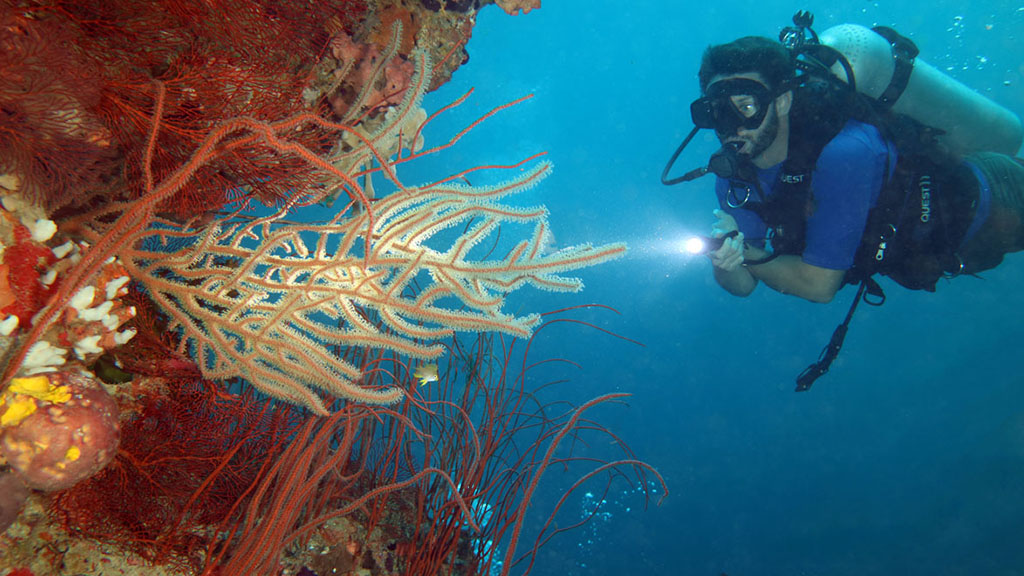
Vanua Levu is home to three different dive areas: the Great Sea Reef to the north, which arcs 200 km towards the west, the Namena Marine Reserve and the famous Rainbow Reef with its Great White Wall.
Taveuni, just across the Somosomo Strait from Rainbow Reef provides possibly the easiest access to dive the world famous reef.
Scattered south of Taveuni are the Lau Group of islands, divable only via private charter, or a small cruise/dive ship like the MV Reef Endeavour.
To the south of Viti Levu is Kadavu and its magnificent Great Astrolabe Reef, home to big fish like tuna and marlin and a place where you can routinely dive and snorkel with manta rays.
Immediately to the north of Kadavu, back on the southern coast of Viti Levu is Beqa Lagoon, Fiji’s shark diving capital. But Beqa Lagoon is not just shark diving, the 144 km long reef around the lagoon has dozens of colourful soft and hard coral dive sites.
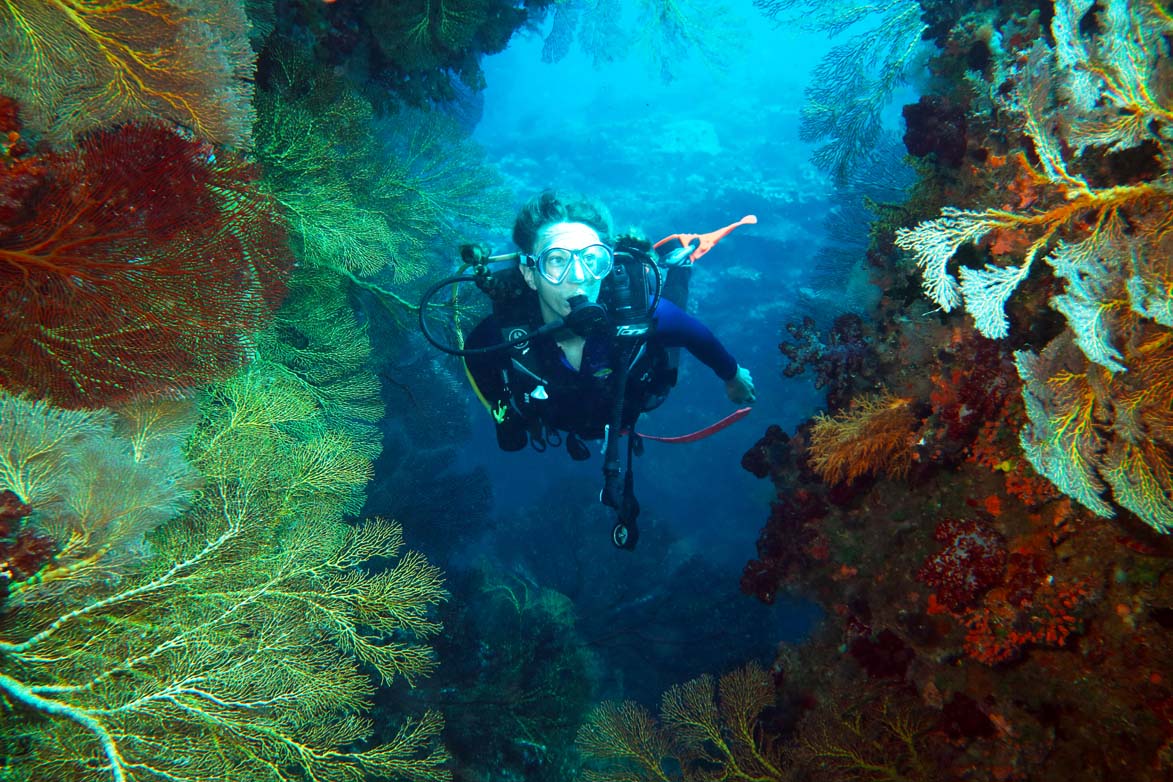
In the south west of Viti Levu lies the Coral Coast – a name that gives away what you’ll find just offshore: walls of coral reefs with steep drop offs and visiting pelagics.
Running from the southwestern tip up to the northwest is the Malalo Sea Reef which provides shelter to the waters around the Mamanuca Islands resulting in that calm, tropical vision of paradise so typical of Fiji. Diving is the Mamanucas is likewise laid back whether drift diving on the walls on the ocean side of the barrier reef, or on the coral bommies on the lagoon side.
To the north lie the Yasawa Islands, now featuring a new shark dive, and a shark snorkel, in addition to the well-established manta ray snorkel. The rugged islands present equally rugged underwater terrain with a great diversity of marine life.
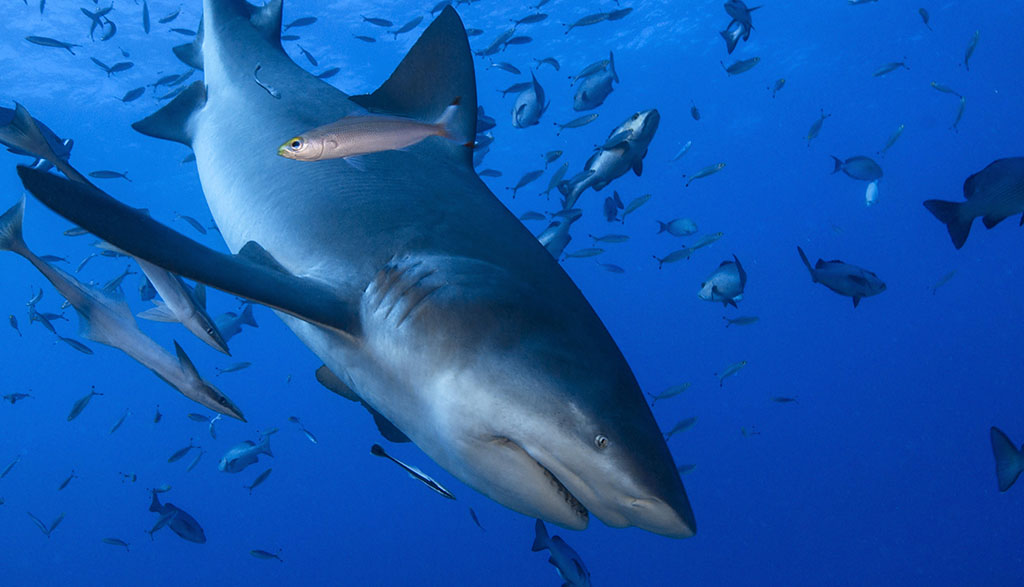
Baffled by the options? We listed Seven Great Ways to Dive Fiji – in one post just for you.
Need some inspiration? Read about our top diving destinations and things to see underwater.